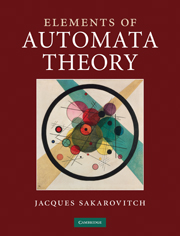0 - FUNDAMENTAL STRUCTURES
Published online by Cambridge University Press: 05 September 2013
Summary
As its number indicates, this chapter was not written to be read. Here will be found reminders of more or less standard notions and structures which are used in this book, with their notation. The intention is that the reader should come here when the need arises.
This reader will however note that Sections 3 and 4 deal with words, a notion which it would be dishonest to brand ‘standard’ in the same sense as, for example, set union or the product of two matrices. In fact, and unlike the usual mathematical point of view which deals with numbers – a measure of continuous magnitudes – and with the related notions of functions and functionals, computer science, or at least that part which abstracts from the physical realisation of computers and concentrates on the problems of information processing, deals with sequences, usually finite, of symbols. These are words. This most general notion is not intended to conceal a vacuous concept; on the contrary, the variety of situations that it encompasses gives it its richness. It is well worth some definitions, and, for neophytes, the corresponding sections merit a detour.
Sections 7 and 8 are also rather non-standard outside the computer science community. Section 7 recalls some basic definitions of graph theory. It is not a preliminary to automata theory (all of whose definitions are given in Chapter I); rather, it allows us to refer, in some results on automata, to corresponding graph-theoretic results. Section 8 tackles more fundamental subjects, sketching the two notions of the complexity of a procedure and of the decidability of a problem.
- Type
- Chapter
- Information
- Elements of Automata Theory , pp. 7 - 46Publisher: Cambridge University PressPrint publication year: 2009



